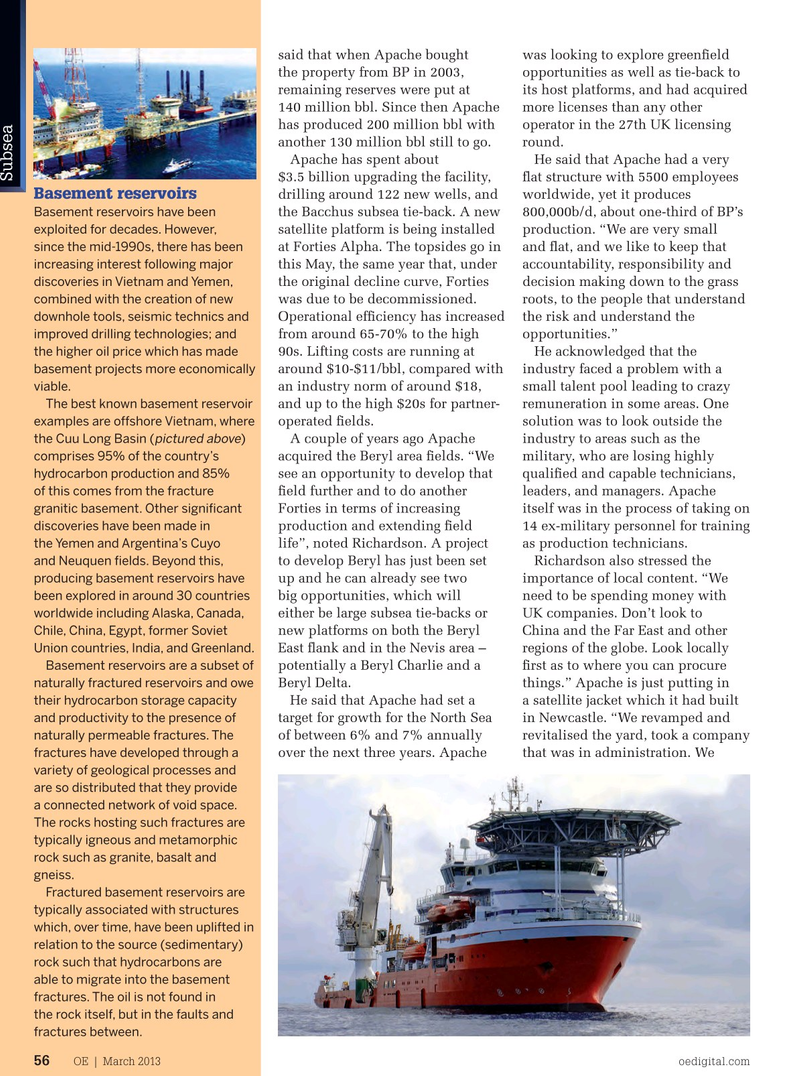
Page 54: of Offshore Engineer Magazine (Mar/Apr 2013)
Read this page in Pdf, Flash or Html5 edition of Mar/Apr 2013 Offshore Engineer Magazine
said that when Apache bought was looking to explore greenfeld the property from BP in 2003, opportunities as well as tie-back to remaining reserves were put at its host platforms, and had acquired 140 million bbl. Since then Apache more licenses than any other has produced 200 million bbl with operator in the 27th UK licensing another 130 million bbl still to go. round.
Apache has spent about He said that Apache had a very
SubseaSubsea $3.5 billion upgrading the facility, fat structure with 5500 employees drilling around 122 new wells, and worldwide, yet it produces
Basement reservoirs the Bacchus subsea tie-back. A new 800,000b/d, about one-third of BP’s
Basement reservoirs have been satellite platform is being installed production. “We are very small exploited for decades. However, at Forties Alpha. The topsides go in and fat, and we like to keep that since the mid-1990s, there has been this May, the same year that, under accountability, responsibility and increasing interest following major the original decline curve, Forties decision making down to the grass discoveries in Vietnam and Yemen, was due to be decommissioned. roots, to the people that understand combined with the creation of new
Operational effciency has increased the risk and understand the downhole tools, seismic technics and from around 65-70% to the high opportunities.” improved drilling technologies; and 90s. Lifting costs are running at He acknowledged that the the higher oil price which has made around $10-$11/bbl, compared with industry faced a problem with a basement projects more economically an industry norm of around $18, small talent pool leading to crazy viable.
and up to the high $20s for partner- remuneration in some areas. One The best known basement reservoir operated felds. solution was to look outside the examples are offshore Vietnam, where A couple of years ago Apache industry to areas such as the pictured above the Cuu Long Basin ( ) acquired the Beryl area felds. “We military, who are losing highly comprises 95% of the country’s see an opportunity to develop that qualifed and capable technicians, hydrocarbon production and 85% feld further and to do another leaders, and managers. Apache of this comes from the fracture
Forties in terms of increasing itself was in the process of taking on granitic basement. Other signifcant production and extending feld 14 ex-military personnel for training discoveries have been made in life”, noted Richardson. A project as production technicians.
the Yemen and Argentina’s Cuyo to develop Beryl has just been set Richardson also stressed the and Neuquen felds. Beyond this, up and he can already see two importance of local content. “We producing basement reservoirs have big opportunities, which will need to be spending money with been explored in around 30 countries either be large subsea tie-backs or UK companies. Don’t look to worldwide including Alaska, Canada, new platforms on both the Beryl China and the Far East and other
Chile, China, Egypt, former Soviet
East fank and in the Nevis area – regions of the globe. Look locally
Union countries, India, and Greenland.
potentially a Beryl Charlie and a frst as to where you can procure Basement reservoirs are a subset of
Beryl Delta. things.” Apache is just putting in naturally fractured reservoirs and owe He said that Apache had set a a satellite jacket which it had built their hydrocarbon storage capacity target for growth for the North Sea in Newcastle. “We revamped and and productivity to the presence of of between 6% and 7% annually revitalised the yard, took a company naturally permeable fractures. The over the next three years. Apache that was in administration. We fractures have developed through a variety of geological processes and are so distributed that they provide a connected network of void space.
The rocks hosting such fractures are typically igneous and metamorphic rock such as granite, basalt and gneiss.
Fractured basement reservoirs are typically associated with structures which, over time, have been uplifted in relation to the source (sedimentary) rock such that hydrocarbons are able to migrate into the basement fractures. The oil is not found in the rock itself, but in the faults and fractures between.
OE | March 2013 OE | March 2013 oedigital.com 5656 oe_SubseaUK_rev2.indd 56 27/02/2013 11:57

 53
53

 55
55